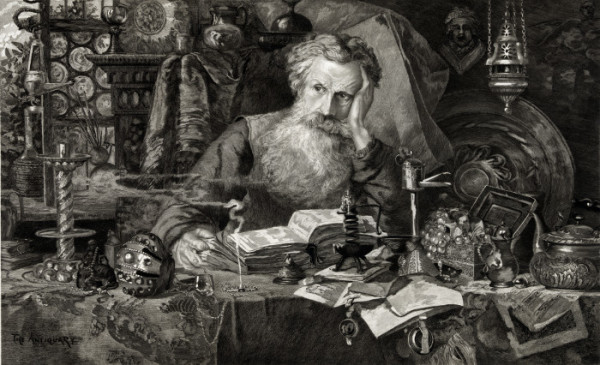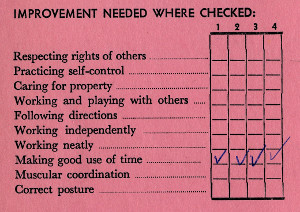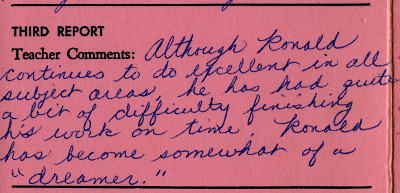Last summer my mom handed me a box of stuff that she’d collected throughout the years. You know, “mom stuff,” including photos of me with toothless grins, report cards, certificates of achievements, class assignments, etc.. One of the documents made me smile.
“Miss Mobilia,” I sighed while studying my second-grade report card. I remembered her as a petite, raven-haired young woman who wore flower-patterned mini-skirts awash in Kodachrome colors. I was quite smitten with Miss Mobilia, but according to the report card, she wasn’t as fond of me.
“Ronald is doing very well,” she commented. “His efforts are most diligent. I would, however, like to see Ronald make better use of his time.”
This wasn’t the only mention of the issue. According to four little checkmarks, I carried the problem for the entire school year.
“Making good use of time” brought back strong memories of conversations with my parents. The phrase drove them crazy.
“Miss Mobilia says that you daydream. Why can’t you just pay attention in class?” they’d ask. Back then, I couldn’t explain. Today, I can.
Miss Mobilia expected her class to study subjects on a rigid schedule. For example, we had math for 45 minutes, followed by 45 minutes of science, followed by 45 minutes of English. Yet my brain didn’t work that way. I just couldn’t turn it on and off on queue. Just as I got interested in the first topic, she shifted to a second one. By the time I switched my focus to the next subject, I had already fallen behind the class. These delays cascaded throughout the day to a point where I needed to catch-up while the kids were at recess.
But, whatever issue I had with “making good use of time,” it had no effect on my grades–the lowest being a generous B+ in penmanship. (Do they still have penmanship?)
“Thinking is the hardest work there is, which is probably the reason so few engage in it.” Henry Ford
Miss Mobilia never broke my daydreaming habits. I’ve been a daydreamer ever since and I encourage budding storytellers to do the same.
Great storytellers daydream. They’re naturally curious beings–compelled to dig deeper into their subjects. When presented with only two options, they’ll seek a third alternative. Storytellers see the same objects as everyone else but refuse to describe them the same way. Instead, they look for nuances, imperfections, and meaningful attributes. They attempt to learn lessons, uncover underlying truths, and create interesting ways to express them through the art of story.
Do you want to become a better business storyteller? Then daydream more and capitulate less. Be curious. Look at your products and services differently. Imagine them in different environments. View them from different perspectives: top, bottom, front, back, sides. Apply different points of view, such as trying to see them through the eyes of your customers, your vendors, or your competitors. If your product has three traditional uses, stare out the window until you uncover a fourth, fifth, or sixth. Refuse to acquiesce into the conventional viewpoints of your peers, senior management, family, and social circles. Create your own.
Miss Mobilia’s final comment about my inability to “make good use of my time” said:
“Although Ronald continues to do excellent in all subject areas, he has quite a bit of difficulty finishing his work on time. Ronald has become somewhat of a ‘dreamer.’”
I still am, Miss Mobilia.
Thankfully, I still am.
Photo credit: Library of Congress


